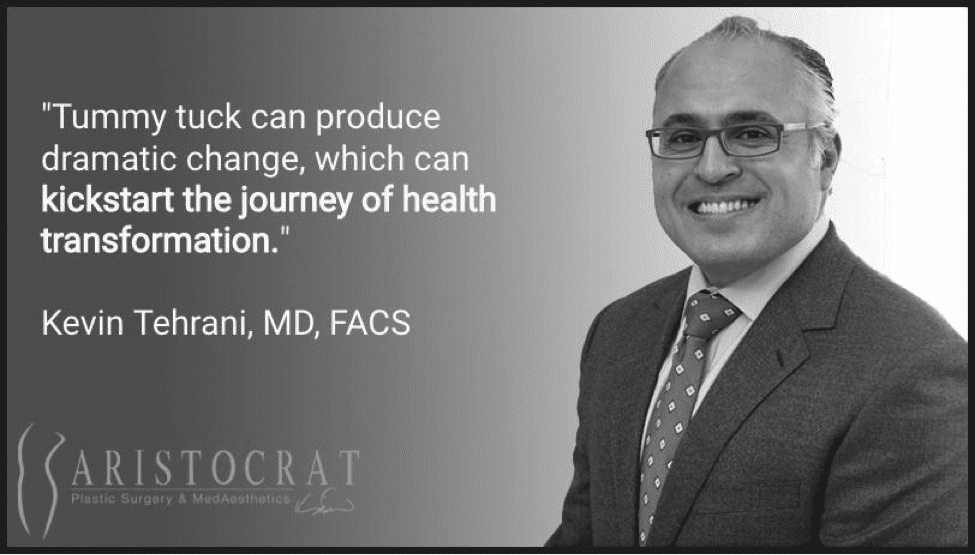When Diets Don’t Work
How to Get Rid of Belly Fat When Diets and Exercise Don’t Work
Exercise is hard. Keeping track of your diet is even harder. Luckily, there are many eating tricks that are easy to implement—tricks that could help you eat fewer unhealthy calories. And, if that doesn’t work, surgical options are available.
We all know that exercise and diet are the cornerstones of weight loss. We all know how hard it is to keep to a strict regimen. We know how disappointing it is to spend months in the gym only to realize that you haven’t really lost all that much—or that those love handles didn’t shrink an inch.
Ultimately, weight control comes down to our day-to-day choices. In this article, you’ll find lots of useful and interesting tips and tricks on how to subconsciously make yourself eat fewer calories, replacing them with healthier, more nutritious foods.

You’ll also find surgical options on what to do if these tips don’t work. While plastic surgery should never be considered a “weight loss” technique, it can put a person back on their feet in terms of their motivation to work out and lead a healthy lifestyle. We’ve seen it happen, and we’re keen believers that surgical intervention can be a strong driver of healthy change.
Eating Tips and Tricks
Dieting is hard. Luckily, there are several eating tips and tricks that will help you eat fewer unhealthy calories and digest food better.
Implementing these tips is easy, and that’s the whole point. Taking these baby steps is the perfect start to your weight control journey.
1. Eat Slowly
Ever had the feeling that you ate way more food than you actually wanted? Or perhaps you’re a serial over-eater, and cannot restrain yourself from stuffing your belly with everything you see inside the fridge?
Science has shown that our brains need time to process how much food is enough. In other words, our appetite mechanism is always lagging slightly behind.
A simple solution to the problem is chewing slowly. Not only chewing slowly and carefully prolongs the entire eating process—which will give time for your appetite mechanisms to kick in—you’ll also make food easier to digest. Chewing slowly and deliberately is associated with lower calorie intake, a higher sense of fullness and lower food portions.
Chewing slowly might be weird at first, but people get used to it in a few days. The most important thing is to control yourself at the beginning and not allow to drift off back to the old chewing patterns. One thing you could do is set a specific number of bites for every bit of food you eat, and actually count the bites in your head.
Another potentially game-changing tip you could try is social eating. Not only planning your meals with friends, colleagues and family (as opposed to eating alone) will do wonders for your social life, it will foster slower eating. A recent study of 23 subjects has shown that people who take longer to finish their meals are less likely to gain weight. On the contrary, rapid eaters are more likely to suffer from obesity.
Overall, eating and chewing slowly can be an easy and natural way to feel full while eating fewer calories.
2. Use Small Plates for Less-than-healthy Foods
While the causality is thin, there is some evidence that eating from big plates is associated with larger food and calorie consumption. For many reasons, plates we use today are much larger than those used just a few decades ago. Some say that there may be a link between this tendency and weight gain in the society.
The most basic logic behind the reasoning is that larger plates can simply accommodate more food. When there’s room for an extra hot wing, we’re unconsciously driven to fill the space with something edible. This instinct, as advocated in the Sapiens by Y. N. Harari, comes from the very primal stages of humanity: a caveman who finds a blueberry bush knows not when will his next meal come or where it will come from; protective mechanisms dictate to stuff yourself with as many blueberries as you can.
In practice, it is suggested to use small plates for the less healthy foods (e.g. deep-fried foods), and using larger plates for vegetables, fruit and other goodies.
There’s also a mental trick to it: cleaning your plate sends a signal to your brain that the eating process has ended, and that you shouldn’t feel hungry anymore. To the least, you’ll have to get up and make your way to the kitchen if you want to get that extra wing—which might be just enough to make you reconsider.
3. Eat Lots of Protein
Once again, while the causality is not yet fully clear here, there is good evidence that a higher protein intake is associated with lower calorie consumption.
One possible explanation why this works is that protein affects several hormones that control our hunger and invoke a sense of fullness, thus allowing us to eat less without feeling constantly hungry.
It has been clinically shown that an increase of protein intake from 15% to 30% of the entire calorie regimen has helped trial subjects eat 441 calorie less every day on average. The subjects had lost 11 pounds in the period of 12 weeks without consciously restricting themselves from any particular foods.
As far as tips and tricks go, breakfast is a great opportunity to pump up the protein intake. If you like to eat oatmeal for breakfast, you might want to consider switching to eggs and buttered toast.
One trial that studied obese women has found that when the trial subjects switched to eggs for breakfast, they ate less for lunch, compared to women who made oatmeal for breakfast. They also ended up eating fewer calories for the rest of the day and for the next 36 hours.
Protein-rich foods include chicken breast, fish, greek yoghurt and almonds. Consider adding those into your diet.
Increasing the protein intake is a great way to reduce daily calories because it makes you eat less unconsciously.
4. Throw Away or Hide Unhealthy Foods
Science has proven that we eat what we can see. This means that if your eyes constantly meet crisps and pizza, that’s what you’ll be consuming.
Clinical trials have shown that people who live in an environment where unhealthy foods are constantly visible tend to weigh more on average compared to subjects who can only see a bowl of fruit on the table.
The solution is simple: either don’t keep unhealthy foods in the house, or put them somewhere you can’t see. If you want to take an extra step, put those salted cookies on the top shelf where you can’t reach them. Even such small adjustments can make you reconsider eating less-than-healthy foods, or you could even forget about them half of the time.
A good thing to do is to put the unhealthy foods somewhere you’re not used to eating. For example, if you put those crisps in your work desk drawer, you might not feel as tempted to go for them as you would if they were neatly waiting for you on the kitchen table.
At the same time, make sure you put the fruit on display. Make sure the fruit are washed and readily waiting for you.
5. Beat Hunger with Fiber-Rich Foods
Constant sense of hunger is one of the biggest roadblocks to effective weight loss. It is very difficult to refrain from eating your regular amount of daily food when you’re feeling hungry all the time.
Fiber-rich foods, such as beans, wheat, Brussels sprouts, asparagus, oranges or linseed are proven to help people maintain a sense of fullness for longer and, in turn, eat fewer calories a day.
Fibers that are viscous and dense are particularly helpful in weight loss as they slow down digestion. When viscous fibers encounter bodily fluids, it forms a gel-like substance that takes longer to leave your body. While this may make you feel a little more tired (as digestion uses your body’s energy resources), it is almost guaranteed to make you feel full for longer, thus enabling you to eat less.
6. Drink Lots of Water to Feel Full
A stomach full of water will never feel quite as good as a stomach full of Mexican wrap, but it will provide you with a sense of added fullness after a meal.
One study has found that drinking 17 oz of water 30 minutes before a meal has lead the trial subjects to feel full quicker and reduce the overall calorie intake as a result. Subjects who drank water before their meals lost 44% more weight over the course of 12 weeks, compared to the control group who did not do that.
Replacing calorie-rich drinks—such as coke or juice—with water can enhance the effect.
7. Serve Smaller Food Portions
One of the most important decisions you can make when trying to reduce the calorie intake is the size of your food serving. Serve a full plate, and you’re likely to eat the whole meal without thinking twice. Control your portion size, and you might just reconsider going for a second serving.
Over the course of the last few decades, the serving sizes in restaurants has increased significantly. Multiple studies have confirmed a link between larger food servings and weight gain/obesity. For example, one study has found that doubling the size of snack servings has led the trial subjects to consume 30% more calories.
8. Put the Phone Away, Turn the Telly Off
It has been found that electronic distractions while eating cause people to eat more. The impulses act on a subconscious level: when we’re distracted by a television show or a video game, we tend to lose track of our senses and eat more. This can lead to overeating.
A poll of 24 subjects has found that people who ate with electronic distractions on tended to stay behind the table 10% longer, eating more as a result.
Being in the moment when eating is also important in weight loss, science says. It turns out that being distracted when eating (e.g. walking around and grabbing a snack every once in a while or reading an article) caused people to absorb fewer nutrients and eat 25% more calories later the same day—compared to subjects who were completely focused on their lunch.
We cannot control our impulses, but we can control how we eat our meals. Being distracted while eating is strongly associated with eating significantly more calories and weight gain.
9. Sleep Well and Learn to Reduce Stress
A piece of ancient wisdom, as true today as it was 10,000 years ago: stress and exhaustion have a powerful impact on your weight and appetite. It has been shown clinically multiple times that people who suffer from sleep deprivation and chronic stress experience a hormonal disbalance, which can increase their appetite and the desire for unhealthy foods.
What’s more, chronic sleep deprivation and stress can increase the chance of diseases such as type-2 diabetes and obesity.
10. Get Rid of Sugary Drinks
It is no secret that sugar-rich drinks, such as sodas and processed juice, are bad for your health. However, not everyone knows just how bad these drinks are for your weight control.
Sugary drinks are strongly associated with an increased risk of numerous diseases. However, that’s not the point we’re trying to make.
The biggest reason why sugary drinks are bad for your weight is because it’s much easier to consume calories in liquid form. Our brains simply fail to register the calories contained in liquids. And, oh boy, do sugary drinks have calories.
Failing to control your intake of sugary liquids can easily lead to overconsumption of calories—exactly the opposite of what you need to be doing if the goal is to lose weight.
On the contrary, replacing sugary sodas in your diet can produce a tremendous impact on your calorie intake. Consider switching to tea, coffee and water—and watch yourself lose pound after pound.
11. Serve Less-than-healthy Foods on Red Plates
There’s a weird trick that could help you be more conscious about the unhealthy food intake in your diet.
The trick is to serve snacks, crisps, deep-fried foods and other not-so-goodies in red plates. Science says that this method at least works for snacks.
One study in particular has shown that the participants ate fewer snacks from red plates, compared to white or blue ones. A possible explanation could be that the red color acts as a subconscious “stop” signal; however, it is just as likely that we simply become much more cautious in regards to what we’re eating from red plates.
Eating Tips & Tricks Summary
Chronic overeating that leads to weight gain and health problems is mostly an automatic response, governed by our impulses and emotions. These impulses and emotions made sense for cavemen—you’d stuff yourself full everytime as well if you didn’t know when or where your next meal would come from—but they do more harm than good for the modern citizen.
Luckily, understanding our evolutionary traits gives us the tools to make our automatic responses work for us, instead of against us. Tips and tricks described previously work on a subconscious level—which makes them so effective.
It’s best to try these things one at a time, to discover what works and what doesn’t. Even more important is to understand the logic why they can work, and experiment with your own routine. You might come up with rules that work specifically for you.

What to Do If Tips and Tricks Don’t Work?
If strict diets and continuous exercise is not an option—but you still need to lose weight—there are surgical options you could explore.
Tummy tuck is a major plastic surgery during which significant amounts of belly fat are removed along with excess skin, while tightening the abdominal muscles.
Many people confuse tummy tuck with liposuction. Liposuction is a procedure that is designed to tackle small, stubborn fat pockets that do not give in to diet or exercise. For example, underarm fat or outer thigh fat can be extremely difficult to get rid of through exercise. Liposuction can help in such cases: a small incision is made into the target area, the fat inside the pocket is distorted and is removed through a small tube called a cannula.

The two procedures are often combined and performed in a single session.
It is important to keep in mind that tummy tuck is one of the largest plastic surgeries available in terms of scope. Patients interested in the procedure should study recovery, potential results and side effects carefully before making a decision. Choosing the right plastic surgeon—who will understand your needs and commit to your well-being—is a major factor, too.
Are You a Good Tummy Tuck Candidate?
Naturally, a surgery of such magnitude is not performed on anyone, for reasons both personal and medical.
Generally, tummy tuck is only performed for men and women of good health. Any surgery is a stressful event for the body. For proper recovery, good health is a requirement.
For example, chosen candidates are asked about their previous and existing medical conditions, as well as medications they’re taking. Selected candidates are strictly asked not to smoke at least 30 days before and after the procedure, as smoking slows down healing and increases the chance of a blood clot forming.
In terms of expectations, the best tummy tuck candidate is someone who is looking to get rid of significant amounts of belly fat, while simultaneously tightening the belly skin and abdominal muscles. Abdominoplasty patients are often mothers who have had several children.
Who Is Not a Good Tummy Tuck Candidate?
As we’ve mentioned, tummy tuck is popular among mothers. However, new pregnancies virtually eliminate the results of abdominoplasty. The skin and abdominal muscles get stretched all over again, and the belly comes back. For that reason, it is highly recommended to get tummy tuck if you’re not planning to have children in the near future.
It is also not the best idea to get tummy tuck if you’re determined to lose weight through exercise. Tummy tuck is not considered a weight loss procedure, but rather a belly-tightening one. As such, it should be considered as a last resort option—when nothing else works.
Scars must be taken into account as well. Tummy tuck surgery leaves relatively visible scars in the belly area. While they can easily be hidden under clothes, you might not want to wear a two-part swimsuit. Make sure to discuss scars with your surgeon. Try not to make conclusions based on images from the internet—the size and visibility of the scars completely depends on the person’s skin, body type, and procedural factors.
Final Verdict: Dieting Is Hard; Kickstart Your Health Transformation With Plastic Surgery
Many people feel like they’ve tried it all and nothing had worked for them. They’ve lost their faith in the healthy lifestyle, and have gotten used to the idea of being overweight.
Dieting tips and tricks truly can help. They act on a subconscious level, and can be implemented into your life without much effort. Most importantly, they form healthy habits which stay for good.
If you really want a boost in the health department, plastic surgery is a great option. We’ve helped hundreds of men and women kickstart their healthy lifestyles at a point where it seemed elusive. If you’re interested in that, too, give us a call, and we’ll figure out what’s the best plan for you.

